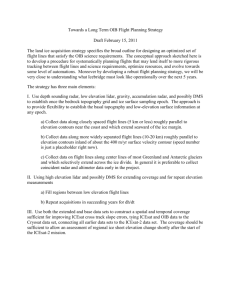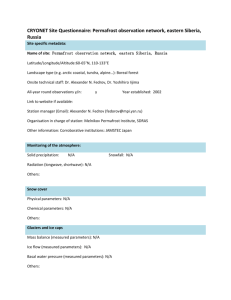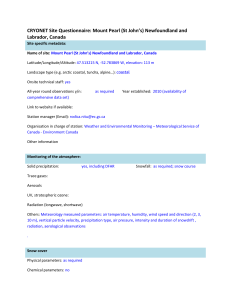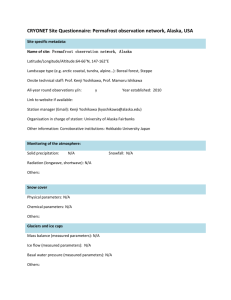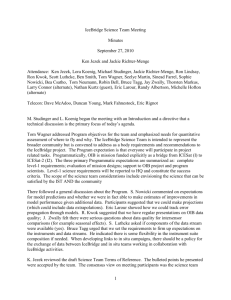Sea Ice Wed/Thurs
advertisement
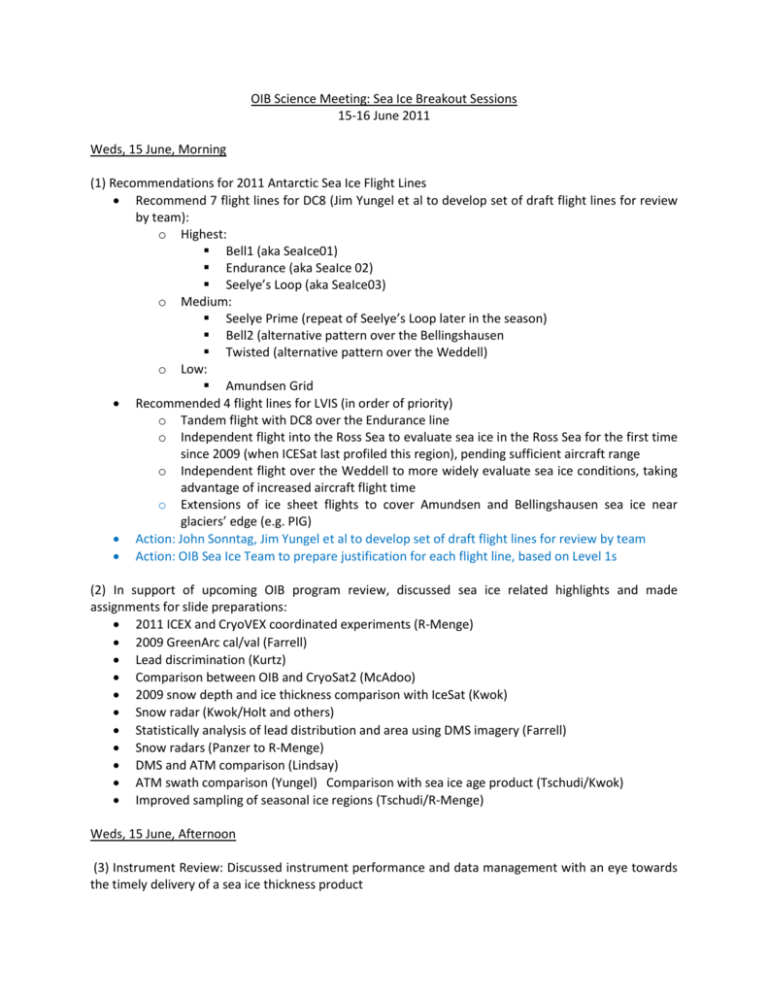
OIB Science Meeting: Sea Ice Breakout Sessions 15-16 June 2011 Weds, 15 June, Morning (1) Recommendations for 2011 Antarctic Sea Ice Flight Lines Recommend 7 flight lines for DC8 (Jim Yungel et al to develop set of draft flight lines for review by team): o Highest: Bell1 (aka SeaIce01) Endurance (aka SeaIce 02) Seelye’s Loop (aka SeaIce03) o Medium: Seelye Prime (repeat of Seelye’s Loop later in the season) Bell2 (alternative pattern over the Bellingshausen Twisted (alternative pattern over the Weddell) o Low: Amundsen Grid Recommended 4 flight lines for LVIS (in order of priority) o Tandem flight with DC8 over the Endurance line o Independent flight into the Ross Sea to evaluate sea ice in the Ross Sea for the first time since 2009 (when ICESat last profiled this region), pending sufficient aircraft range o Independent flight over the Weddell to more widely evaluate sea ice conditions, taking advantage of increased aircraft flight time o Extensions of ice sheet flights to cover Amundsen and Bellingshausen sea ice near glaciers’ edge (e.g. PIG) Action: John Sonntag, Jim Yungel et al to develop set of draft flight lines for review by team Action: OIB Sea Ice Team to prepare justification for each flight line, based on Level 1s (2) In support of upcoming OIB program review, discussed sea ice related highlights and made assignments for slide preparations: 2011 ICEX and CryoVEX coordinated experiments (R-Menge) 2009 GreenArc cal/val (Farrell) Lead discrimination (Kurtz) Comparison between OIB and CryoSat2 (McAdoo) 2009 snow depth and ice thickness comparison with IceSat (Kwok) Snow radar (Kwok/Holt and others) Statistically analysis of lead distribution and area using DMS imagery (Farrell) Snow radars (Panzer to R-Menge) DMS and ATM comparison (Lindsay) ATM swath comparison (Yungel) Comparison with sea ice age product (Tschudi/Kwok) Improved sampling of seasonal ice regions (Tschudi/R-Menge) Weds, 15 June, Afternoon (3) Instrument Review: Discussed instrument performance and data management with an eye towards the timely delivery of a sea ice thickness product To set the stage for this discussion, JR-M presented a block diagram (see Figure 1) outlining the process of transitioning from instrument products (e.g. DMS, ATM, snow radar) to value added products (e.g. sea ice thickness). The diagram illustrates that sea ice thickness is a highly derived product that is dependent on the delivery of a suite of measurements. Figure 1. Block diagram outlining the process for transitioning from OIB instrument products to sea ice VAPs. i) DMS (R. Dominguez) and enhanced products (J. Averson) Critical tool for lead discrimination Significant interest in advanced products being developed by Averson, using DMS images to create a digital elevation model DEM with imagery is draped over it. o In addition to lead discrimination, has potential to provide important information on surface roughness which can be used to distinguish between ice types. o Action: Follow up with OIB Project Office regarding potential for delivering an advanced DMS-based leads detection product (e.g. Averson) to NSIDC Good figures showing indicating the instrument coverage (e.g. when light levels and sky conditions were good enough to collection meaningful data) during each campaign o Action: Follow up with OIB Project Office to request maps of instrument coverage for each campaign Significant loss of data during 2011 Arctic campaign due to low light conditions experienced early in the season o Action: Consider how this situation can be minimized in future campaigns DMS data can be routinely delivered to NSIDC 4 months after the campaign ii) ATM (J. Yungel) Narrow swath width provides significant improvement in returns from leads, therefore improving the quality of the sea surface and sea ice freeboard products. In future, ATM data from both swaths will be provided to NSIDC, though in two separate files ATM data can be routinely delivered to NSIDC 6 months after the campaign o Action: Consider potential for an ATM-derived surface roughness product (beyond that currently provided via the ATM Icessn data, which includes the parameter "RMS fit of the ATM data to the plane"), to help categorize ice types iii) Snow radars: Ku band radar altimeter & UKansas FMCW snow radar (B. Panzer) It was noted that these data have been slow to arrive at the NSIDC archive, if they have arrived at all. Acknowledge that the delay was largely due to the fact that one person (i.e. Panzer) was pretty much doing it all. Resources (i.e. more people) are now available at U Kansas to support this effort, so process and timeline for providing data to NSIDC is expected to become more routine o Action: Kansas to provide all back data to NSIDCASAP o Action: Kansas is to provide elevation data (in addition to radar echograms) derived from the Ku band radar to NSIDC. o Action: Kansas to supply code to NSIDC to read their raw, binary Ku-band radar echogram data, to allow users to start looking at this data. Working to reduce size of data files by effectively “windowing” the data, so as to only supply the radar return power close to the surface. Reduction in file size will positively affect (i.e. speed up) data reduction process I think Ben meant he would effectively “window” the data so as to only supply the radar return power close to the surface, discarding all other data in the waveform range window Potential to provide a more advanced snow product o Action: Outline characteristics of an optimal snow product Realistic to expect data delivery 6 months after campaign Thursday, 16 June, Morning (Continue instrument review) iv) LVIS (Bryan Blair) Now have time-tagged photos Sea ice team suggest list of parameters (via email from Farrell) that, if provided, may further advance the use of the LVIS product: 0. Ground elevation (Zg) (already provided) 1. Elevation of first return (Zt) 2. Goodness of fit between Gaussian and waveform 3. Skewness of Gaussian fit 4. Number of peaks in the waveform (number of Gaussian fits?) 5. X-correlation between the Tx and Rx waveform 6. Surface roughness? (information content of the waveform/entropy of the waveform?) 7. Tx and Rx pulse width from the first Gaussian fit 8. Incident angle (of Rx waveform) 9. Energy of the Tx and Rx waveforms 10. Estimate of waveform noise floor 11. Standard deviation of the noise floor 12. Area under the Tx and Rx waveforms 13. Waveform channel number (i.e. high, medium, low waveform being reported in L1B data set) 14. LVIS Camera photos provided with time tags. o Action: Schedule follow-up discussion to further refine this list of parameters and to find out the likely timeline on processing the L2 data for the sea ice data collected during previous campaigns. v) CULPIS-X (M. Tschudi) OIB project that will provide new stream of sea ice data to NSIDC Currently no snow radar; need to supplement with data from other sources (e.g. ground measurements, other platforms) Encourage flights along the northern coast to complement OIB Arctic campaign vi) Thermal Imagery (general discussion) Thermal imagery nice to have, but not necessary for lead detection More interest in data from KT-19 o Action: Prepare email requesting reinstatement of KT19 as part of the ATM package on the P3 to collection data on surface temperature Thursday, 16 June, Afternoon (4) Sea Ice Value Added Products: Sea Ice Thickness Quality of ‘quick look’ instrument products are not suitable for deriving a sea ice thickness estimate in a timeframe that would be useful as input for short term (e.g. days/weeks) or seasonal forecasts (e.g. NOAA Sea Ice Outlook) Focus should remain on: o Timely production of a high quality sea ice thickness product that will fill the gap in sea ice thickness observations between IceSat and IceSat2, providing critical information on climatological trends o Timely production of snow depth estimates, a unique contribution of IceBridge o Opportunities for cal/val of snow depth and sea ice thickness products Realistic target for the routine delivery of a sea ice thickness product is 1 year after the campaign o Action: Prepare email to T. Wagner outlining the sea ice VAP discussion o Action: OIB Sea Ice team to work with OIB Project and NSIDC to establish a process for the routine delivery of the sea ice thickness VAP 1 year after the conclusion of a campaign.




